"Fenceland" (The Greatest Show On Earth!)
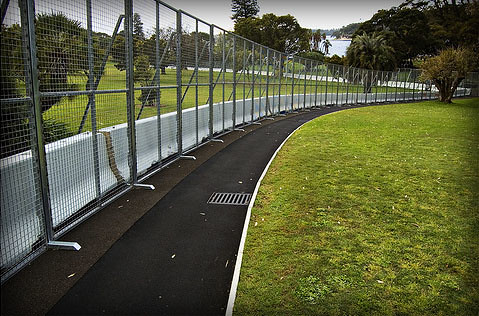
[Image: The APEC Fence in Sydney, photo via The Sage of Shadowdale.]
Well, the “APEC Fenceland” has come and gone now after the world’s top geopolitical brass camped out in Sydney all last week. In light of the G8 Summit held in Germany earlier this year the movements and installations of these roving fortress productions sure are getting lots of practice and therefore I guess not surprisingly all the more streamlined, like “the efficient business of event management” as this article writes; dare I even say, elegant.


[Images: Via Circula Quay 2.]
It’s more than a little ominous, actually. These types of scaled moments seem more like rehearsals for something much bigger on the horizon, a sequel around the corner. I don’t know what exactly that would entail, but they just create this atmosphere of some future event to come that you may not want to be there to experience, exactly. In other words, this flexing of state power is a kind of indirect terror, or something. Maybe it’s just another version of that old classic march of troops and missiles on flatbeds in the streets, that preeminent televised showing of military capability to the rest of the world, which as we all know now is usually just posture. Either way, even when it’s passed it leaves something hanging in the air that doesn’t quite sit right.
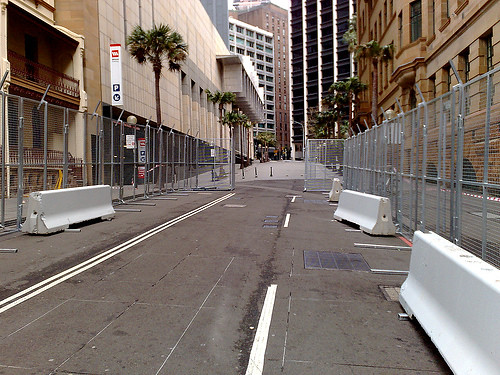
[Image: Photo via edwardaggie98.]
I wonder to what degree these mighty spectacles are becoming all the more sensationalized almost as a kind of transnational pop-up architectural performance art; or, a surreal militaristic carnival parading in the temporary occupation of the city. More so, I have to wonder, am I the one doing all of the sensationalizing over here?!

[Image: The BBC covers the construction of the APEC security fence in Sydney.]
Anyway, I am curious now that the big urban border party and all its defensive accoutrement has been taken down what if anything has been left behind? Put differently, do these grandiose security performances deposit any sort of insidious permanent mark on the city; will Sydney remain somewhat invisibly re-militarized after the show has moved on? To that end, what about the cultural imprints; has anyone asked – what are the psychological effects of these spectacles on residents? Maybe I am searching for too many implications here – but hey, that’s my job!
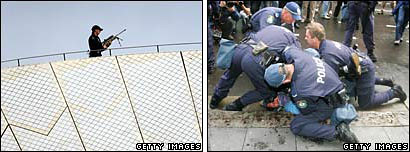
[Image: Photo from the BBC, Bush Arrives at fortress Sydney.]
One of the things that most struck me was just how seemingly clean and meticulous the Sydney production appeared. Did you see those barriers, those posters, the marketing material? Well, neither did I, really, but it looked like the more sophisticated side of Subtopia had swooped down in a massive flock of urban barricades and took a fat vacation there, or more appropriately, hosted our own pow-wow. Really, the APEC security scheme was almost all-too-professional; and ironic in the way it advertised for an event that no one could technically be a part of. Compared to Baghdad’s surge walls or the old insurgent urbanism of Northern Ireland, the Aussie approach took on a massive somewhat seductive boutique-like meandering of military urbanism, so carefully ordered and assembled, all lined up flush with the edges of the sidewalks, fashioned even more so by a perfectly arranged orange carpet of street cones.
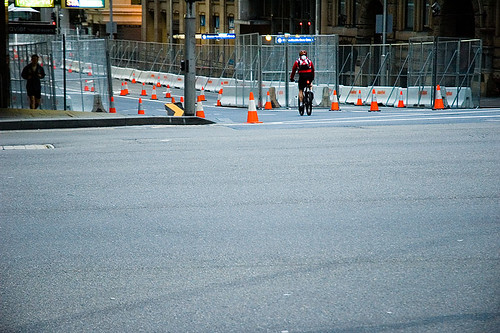
[Image: via Pong.]
I can’t believe I’m saying this but – it was almost done with a sense of style. All that stuff looked to me a little too bizarrely decorative to even be real. I mean, make no mistake about it – it was real, but from my vantage it seemed like one big weird window-shopping experience for the residents there, limited to these strict gazing corridors, an absolute arcade for the media. Only in this case the shutters and the bars on the windows and all of the sidewalk caging and detour signage itself were the products on display. It’s similar to the US/Mexico border fence in the sense that it has become a strange sort of tourist attraction these days.
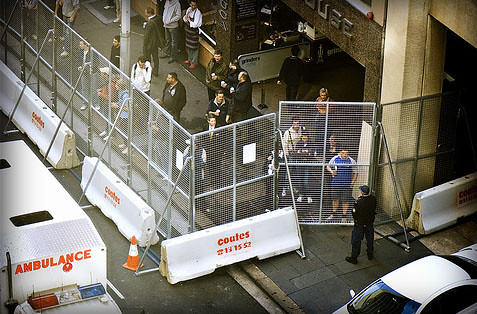
[Image: Photo via The Sage of Shadowdale.]
But I clearly have my own obsession with this stuff and an unwieldy tendency to over-scrutinize the aesthetics and fetishization of border fences now. I’m working on that - promise.
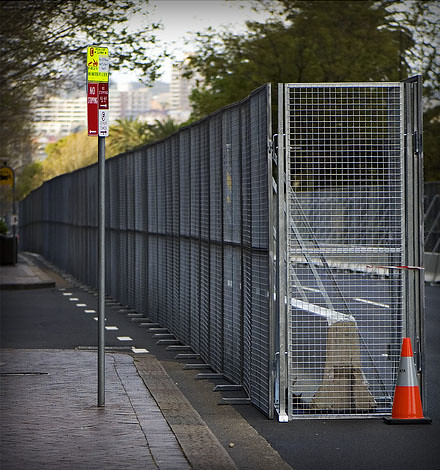
[Image: Via The Sage of Shadowdale.]
So, even though neither you or I were there to stroll around the eerie evacuated streets, past the streamers of lightweight warnings and flexible blockades, or what we might call a temporary new aged market place of geopolitical medievalism, a few of our fellow bloggerades hunkered there down under did a more than brilliant job of covering this Subtopian escapade. Let me cull together some of what they had to say for you:
Thanks to Marcus Trimble we get a good technical overview of what he called the “Pink and Purple Zone” alluding to Sydney’s security makeover impersonation of Baghdad’s ‘Green Zone.’

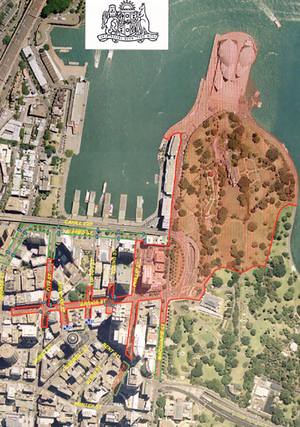
“Five kilometres of fencing ha(d) been erected around the Opera House, parts of Macquarie Street, Bridge Street and surrounding side streets,” he said. With concrete basing the fence stood 2.8m-high (9.2ft) over this portion of the city that was referred to by APEC security planners as The Declared Area, “in which,” Marcus goes on to write, “the NSW Police ha(d) been granted magical new abilities to search people for whatever reason they like. If they think that you look a little suspect, then the games over. The prisons have kindly kept some spare space for all the extra arrests expected over the course of the conference.”
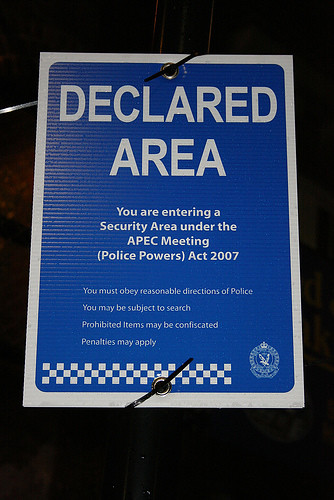
[Image: Photo via marcel.wegermann.]
In terms of statistical figures for the entire operation, the Sydney Morning Herald's survival guide listed these numbers:
Attended: 21 global leaders, 400 associated business executives, 1500 media persons, 4000 occupied hotel rooms, 4950 police officers on duty, 800 additional security guards on patrol, 500 prison beds especially vacated for arrested protesters, 12,000 clearway road signs, and 1 water cannon. And there were supposed to be some Blackhawk heli’s but in Dan Hill’s experience all he got were those “bulbous police helicopters, sprouting with antennae.” We'll get to that in a bit.
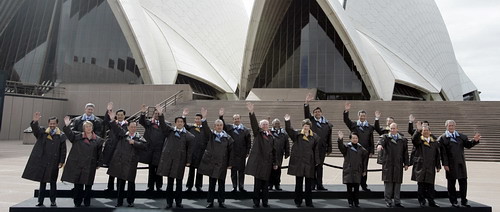
Marcus also tells about Google’s temporary silly fuzzying of satellite images of the area and the ironically timed mounting of loudspeakers through out the streets that would theoretically give instructions to people in the event of a pandemonium. All of which seems impotent in light of what didn’t happen during the week. Though, I’m sure officials would attribute the relative protester passivity to the ingenious web of security they masterminded that week.
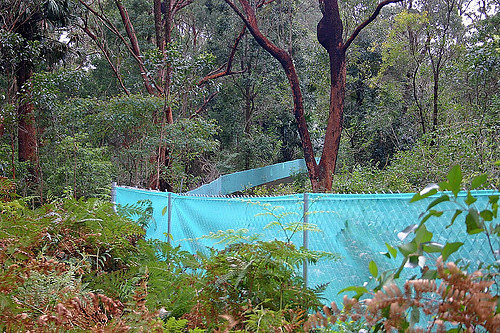
[Image: APEC Is Everywhere, via iansand.]
Nevertheless, Dan also picked up on all of this and am I ever thankful he did. You see, I know Dan’s ability to provide live onsite coverage first hand (as he voraciously and single-handedly documented the entire Postopolis! event in NYC), and so we shouldn’t be at all surprised by his deliciously mordant post wandering through the embellished streets of what he called “The Anti-Fun Palace.”

[Image: Photo/caption via City of Sound: The transport services have been reconfigured too, with bus stops shifting location for APEC and indicating just how malleable the city can be.]
Dan’s descriptions of what I might choose to call a kind of vacant sublime that cloaked the cordoned area in Sydney conjure that notorious image I can’t seem to shake loose from my imagination of a global scale slithering security fence, a Goliath border wall; and what I’ve repeatedly referred to here on Subtopes as the nomadic fortress. Dan writes:
“The Fence is very configurable, allowing different streets to be closed at different times. Indeed, the police occasionally seem unsure which streets to shut off, when.”

Maybe it’s a kind of mock-hydrology of anti-activist militarization, a means for de-irrigating, de-populating the urban zone. However, he also makes some great allusions to London and Archigram and even the popular artist Cristo. So, in his own words:
In the Sydney Morning Herald's special APEC section, John Huxley writes of prison language - 'lockdown' - and the Dead City that's left behind. I find the peculiar atmosphere a little reminiscent of the accidental pedestrianisation of London after the 7/7 bombings, though here cultivated through the power of nightmares rather than actual terror.
In the spirit of Cedric Price or Archigram, you could see the entire fenced structure as one transient building - a kind of tentacular walking city, with its own streets and arteries, overlaid temporarily over the concrete city beneath, as if it's squatting on the CBD, attempting to suffocate or strangle, perhaps.
Of course, it's the antithesis of what Price and Archigram attempted with their visionary work - a kind of Anti-Fun Palace, in which possibilities are diminished and the only course of action is to be shepherded out to the perimeter of the city. From an urban planning perspective, it's the opposite of creating a contemporary open space. You could see the whole thing as a design problem - perhaps run as an avant-garde exercise in a crazed design school somewhere: how to tighten the grip a very public space, centred around one of the country's principle attractions? Again, you begin to look at The Fence as a temporary architectural incursion in the city, a reversal of the usual - or at least more written about - architectural and urban design work. You half wonder where The Fence is heading next.
Indeed – where will The Fence turn up next? And again, I ask: what if anything has been left behind as the kind of permanent entrails of geopolitical militarization? This is all over the news, but for instance, a lot of locals are unhappy with the way this has supposedly tarnished Australia’s image, or killed business - some are demanding compensation for lost profits during the 'siege.' But, I’m more curious about the physical leftovers, of the things that will be conveniently forgetten to bring down; will any type of militarization linger on in the wake of the event?
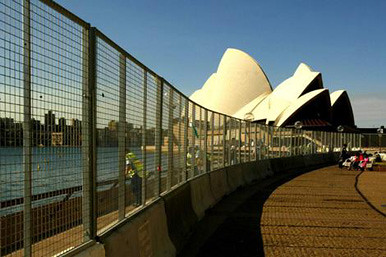
[Image: The Opera House in Sydney behind the APEC Fence, photo via Super Colossal.]
When you see how utterly transformed Sydney was by the armored set design of the whole thing, the billboard marketing, the alternative geographies of mobility within the vicinity of the CBD building (essentially, its own ability to account for the disruptions it would cause), while the real show – the one that wasn’t meant to be seen at all – was staged strategically and interestingly enough inside the demure architecture of the Opera House itself (Australia’s grandest pedestal), the whole thing gave new meaning to what Bruce Schneier called “security theater.”
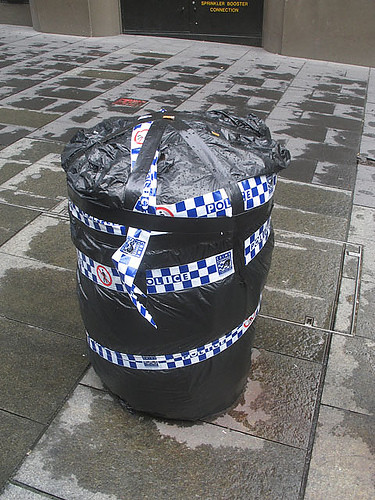
[Image: The trash cans were even incorporated into the drama. Photo via A Reminder.]
Call it Fenceland, a kind of 21st century traveling stage show, an urban drama performed in the dimensions of the city streets themselves; the city as stage, the architecture as set design, security as the ultimate prop for a bunch of invisible antagonists performing in a place that is neither meant to be seen or heard; riffing off of Dan, it's a kind of anti-opera. I mentioned earlier how these types of exhibitions of global security almost seem like rehearsals for something much more looming still to come, but I also can’t help to view such events as the shows themselves, the avant-garde staging of a temporary military occupation of your city, while the media provides the programs and the postcards of what may soon come to a city near you. At $140m, APEC was the global Broadway musical production of military urbanism; this, my friends, is The “New” Greatest Show on Earth!
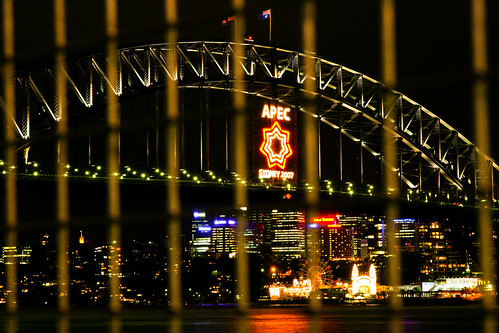

[Image: Above images via Rain.Forest.]
However, to put this all in a completely different but albeit critical political context, Angela Mitropoulos gives us some text from her talk earlier this year at Sydney University which is more than relevant, looking at how global activism is being re-framed not only politically but literally by these types of fortress productions making more and more connections between the ways activists are being treated as the extensions of the detainee. To quote her at length:
the debate over representation was also a debate over whether those protests were anti-globalisation, a manifestation of globalisation (including that of protest), or counter-globalisation, and so on. In other words, were these protests a nationalist response to the forces of neoliberalism (as in an attempt to save nation-states from the ravages of international finance) or a global response to capitalism? It is not necessary to reiterate those debates here, though it might be noted that, locally at least, the turn to noborder campaigns after the anti-WTO protests was a consequence not of declarations of unity and claims to representation, but of an insistence on irreconcilable differences within the anti-summit milieux.
Remarkably, in the midst of the campaigns to close the detention camps, though it often did not pass without challenge, there was – and continues to be – a distinction made between activists and detainees. Briefly put: those outside the camps are identified as activists, those inside as detainees. Underneath this, of course, is a definition of politics, of what counts as political and, moreover, what is to be understood as movement. Ironically, then, those who cross borders without state authorisation are, according to this, not part of a movement, while those whose sense of politics remains fixed by national boundaries reserve for themselves the definition of movement. It might be added, with some rather more grim irony, that the techniques currently deployed against anti-summit protests – of raids, lockdowns, corralling and so on – are all forms of border policing, controls on movement whose less visible laboratory is that of migration control.
In any case, this distinction for some amounts to an argument for inclusion, for opening up or re-defining the category and identity of activism to include those, as with detainees, who are excluded from it. But if one proceeds not from the apparently self-evident question of how to represent, or encompass, everyone or everything – which, put differently, means instead proceeding from a sense of how migration controls function not only as instances of exclusion, but also (as Agamben would put it) inclusive-exclusion – the answer is by no means so simple as expanding the scope of recognition and representation. Or giving out more passports and visas.
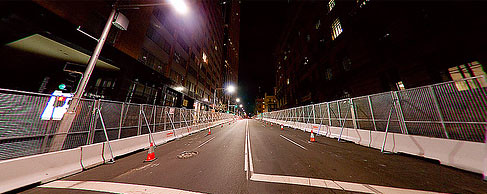
[Image: The APEC Fence, via Jarod_Is_Happy.]
Alright, being that I am out of time right now I just want to say thanks to all who forwarded me links to news sources and articles on the week (I really do appreciate it, and sorry if I didn’t get back to you as quickly as I would have liked), and to Marcus, Dan, and Angela for hitting this up. And to all the rest of you, take note, because you never know when the state of exception may decide to celebrate a holiday in your hometown.
Also, check these links out for more:
BBC Pics
We can build you - APEC and the rise of military urbanism (Stephen Smith)
Australia: Greenpeace activists stage APEC coal protest
Flickr shots
More Flickr
Apec strives to silence doubters
Bush arrives in fortress Sydney
Apec security leaves bitter taste in Sydney
Photo Essay: Sydney APEC 2007 Almost A Quiet Earth







2 Comments:
It's terrifying how this amped-up New South Wales (Sydney) police force use the language of the exception and the exceptional ("temporary measures for this important event"), while then letting the state of exception become the norm.
Witness:
http://www.messandnoise.com/reviews/1221336
I'm becoming fascinated by the "fencing / security" technology and it's 'owners'. Who are these people? They seem to be fencing off everything not just contentious political power events. Concerts, shows, buildings, vacant lots.
I'm beginning to feel like I'm in a medieval world where "barons" of industry travel around among the commoners and keep them at bay with their private armies, fences, and intelligence reports from private security corporations.
I'm beginning to get a little scared by how tight government and these 'barons' are. What does this leave for me? Plenty to be afraid of.
Post a Comment
<< Home